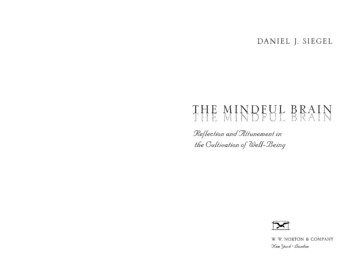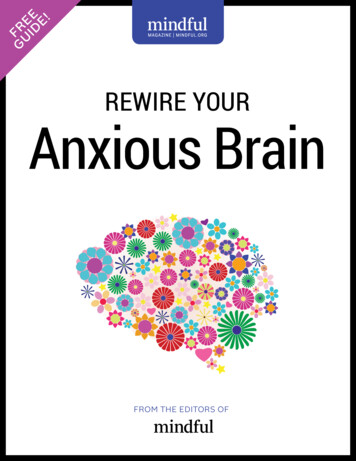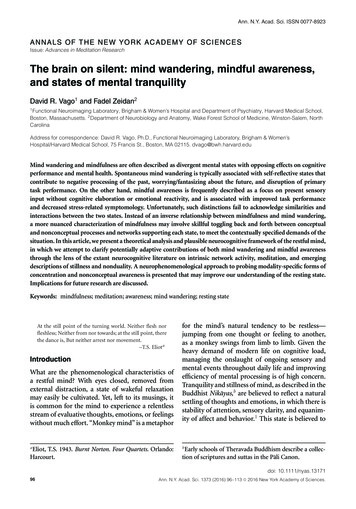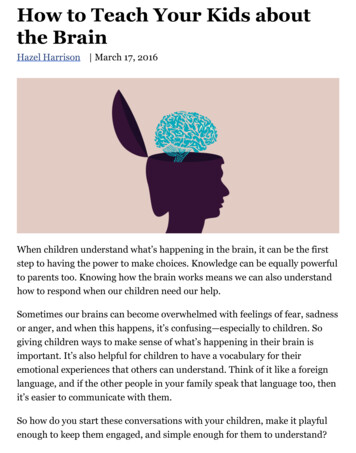
Transcription
DANIEL J. SIEGELTHE MINDFUL BRAIN'I' II E, · tvl I l\J c -F tJ I , 11. I l\ I T\lY effeclion and:Jlflunemenl inI.be Gufliualion of lf!Jeff-2Jein:7t,;1W.W. NORTON fl, COMPANYXem '!:}o.rk Bondon
G apier YourfeenTHE MINDFUL BRAININ PSYCHOTHERAPY::P.romoHny Xeuraf leyralionAs we discussed briefly in the Preface, interpersonal neurobiol ogy is an integrative approach that draws on a wide array of waysof knowing to create a picture of human experience. This ap proach builds on many disciplines of science to propose how wemight define the mind and its emergence in the moment, and itsdevelopment across the lifespan. We've seen that the human mind'can be defined as an embodied and relational process that regu lates the flow of energy and information. The mind emerges asthis flow occurs within and among people, and it develops as thegenetically programmed maturation of the nervous system isshaped by ongoing experience.Through this synthetic analysis emerges the perspective thatmental well-being is created within the process of integration, thelinkage of differentiated components of a system into a functionalwhole. In this view, drawn in part from complexity theory, we seethat when a system's components become functionally linked when they are integrated-they can be defined as having a FACESflow: flexible, adaptive, coherent, energized, and stable. Outside ofthat flow the person, family, community, or society may experi ence chaos or rigidity. In the flow, the experience is filled withco erence: connected, open, harmonious, engaged, receptive, emer gent, noetic, compassionate, and empathic. These working defini-
.7 e YK.indful2Jra.in in :Ayc of11erapy289tions of the mind and of mental well-being have been useful ineducating teachers and therapists to consider a possible view of ahealthy mind.Through· our emerging understanding of the mindful brain wecan build on these ideas to offer a framework for how an inter personal neurobiology approach to therapy may be created.AN INTERPERSONAL NEUROBIOLOGYROLE IN UNDERSTANDINGAND PROMOTING WELL-BEINGPersonal transformation can be considered to involve the threelegs of our triangle of well-being: coherent mind, empathic rela tionships, and neural integration. There is no need to simplifythese three into a single aspect of reality as they're mutually rein forcing. Naturally, being all a part of the energy and informationflow of well-being, we could say these are three aspects of one re ality. But these "three aspects" have unique, irreducible qualities.If integration enables a FACES flow, it is a logical next step toexamine how integration within and among these domains is pro moted. ff we begin on the plane of the physical domain of reality;we can say we are seeking separate aspects of a system which canthen be linked together. Before exploring this approach in detail,let's discpss some general principles.It is important to remember that this is one therapist's experi-'ence, one approach to finding windows of opportunity" to helppeople move toward well-being by promoting integration in theirlives. I offer this view for your consideration, not as a statement ofhow to do some particular therapy, but as one way of being as atherapist. If you are a clinician yourself, or if you are in psy chotherapy, I hope these ideas and the following stories of actualexperiences are of help in illuminating possible avenues of changethat will be useful in creating your own approach. In a mindful
290state we can see others' suggestions as a possible route, rather thanas a roadmap delineating the only way to go. We each are differ ent, our lives complex, and having a sense of possible directionsmay be more helpful than locking on to some idea of an absolutetruth.ATTUNEMENTShared attention initiates attunement. As we engige with oth ers, we mutually focus our awareness on the elements of a per son's mind that become the shared center of the hub of ourminds. As this joining evolves; we begin to resonate with eachother's states and become changed by our connection.Attunement can be seen as the heart of therapeutic change. Inthe moment, such resonant states feel good as we feel "felt" by an other, no longer alone but in connection. This is the heart of em.:pathic relationships, as we sense a clear image of our mind in themind of another. A simple acronym for remembering this featureis ISO, the internal state of the other, an awareness that you as thetherapist have of your patient, and your patient has of you. Eachperson senses his or her mind clearly in the expressions of theother, experiencing that embodiment of one's own authenticmind inside another person. Here we see the notion of "embod ied simulation" of the m.J.rror neuron system (Gallese, 2003, 2006),in which our neural processes integrate what we perceive withour body's priming for action and emotion.Another way in which we attune to the mind of another is byway of a narrative of the other, or NOTO. By taking in the ex periences of the patient, we create a story in our own minds ofwho he or she is. In small and large ways, we can reveal that wehave a narrative of the other inside of us. If a patient comes backfrom a trip to San Francisco and I say upon his return, before hespeaks, "How was your trip to the Golden Gate Bridge?", he will
291know that he exists inside of my head even when we are notwith each other. On a larger scale, a NOTO is revealed in theways in which the life experiences of a patient fill my mind andI can sense her struggles, see her journey in its route across time,and let her know in our discussions how that evolving storyexists in my mind through the ways we connect around makingsense of her life.As patients feel our authentic concern and our capacity to em bed them in us in the present within ISOs and across time withNOTOs, they come to feel felt by us and attuned with us. Toachieve such direct connection, to integrate minds, it is crucial thatthe therapist have an open hub in which· to mindfully receivewhatever arises in the course of therapy This ·attunement not onlyfeels good in the moment, it likely alters the self-regulatory integrative fibers of the brain, especially in the middle aspects of theprefrontal cortex. Attunement interpersonally and the nurturingof attunement internally are the central processes of psychother apy. Attunement of both forms is built upon integration.SNAGGING THE BRAINour attehtion to our intention. W hereIn mindfulne ss we direct'attention goes, neurons fire. And where neurons fire, they canrewire. This process can be summarized by the term SNAG, signifying the way we stimulate neuronal activation and growth. In nindful awareness we are "snagging" our own brain by focusingattention on our own intentions in a way that stimulates our middle prefrontal regions and promotes integration. This prefrontalactivation engages axonal fibers that extend out to link togethervarious disparate regions: cortex, limbic areas, brainstem, body proper, and even the social world of other brains. The growth ofprefrontal fibers anatomically means that functionally, we will bepromoting ,neural integration.
292Internal attm1ement is proposed here to snag the b'rain to pro mote integration. Interpersonal attunement can be seen to cat alyze similar neuronal activation and growth. Attunement then be comes a central focus of our understanding of how therapy canchange the brain.Let's recall the list of nine middle pr frontal functions corre lated with activation of the associated areas of medial and ventralprefrontal, orbitofrontal, and anterior cingulate cortex: (r) bodyregulation, (2) attuned communication, (3) emotional balance, (4)response flexibility, (5) empathy, (6) self-knowing awareness, (7)fear modulation, (8) intuition, and (9) morality. How many of thislist would you include on your desired results for your own orothers' growth in life? From this perspective, we can examine howinterpersonal attunement in attachment, internal attunement inmindfulness, middle prefrontal function, and effective psychother apy might converge in their common mechanisms of action.THE DOMAINS OF NEURAL INTEGRATIONWe can propose that for any form of therapy to be effective wemust "snag" the brain toward neural integration, promote coher ence of mind, and inspire empathy in relationships. This is .howtherapy focuses on the triangle of well-being. The strategy we'lltake to describe this dynamic and individualized process will be todelineate nine distinct domains of neural integration and how topromote each of these within our lives. (Siegel, in press). Thesedomains include those of (r) consc:i:ousness, (2) vertical, (3) hori zontal, (4) memory, (5) narrative, (6) state, (7) temporal, (8) inter personal, and (9) transpirational integration.If we focus on the domains of integration within our neuralsystems, we can see the simultaneous creation of empathy withothers and coherence within. The following vignettes of patients
293(identifying features have been removed from these stories), mayhelp illust ate the use of this approach within psychotherapy, aswe apply the principles of the mindful brain to clinical practice.Jhe gnleyralion ofConsciousnessHi Dr. Siegel . . . just wanted to let you know that I am feeling a wholelot better . . . a bit more clarity on this issue, and a Jar better view of therim . . . it is amazing-and a real insight as a therapist-that how evenknowing and practicing all that I know and practice (i.e., watching mybreathing, COAL, SOCK), niy mind gets hijacked still by,what hap pened so long ago . . . Ifeel much better now'--that nice normal calm feel ing-I think because I have been able to untwist this twisted stuffand canlook at it without twisting myself inside out . . . I have not forgotten itonce yet, and I am feeling like I probably won't lose complete sight of itany more . . . it's kind of like even when I forget, I remember that I forget,and that is sort.of like not forgetting, really . . . I cannot wait to work moreon these aspects of my self next week . . . thanks Dr. Siegel . . . Ijust amso grateful for your guidance . . . see you Wed . . . best, MaryThis is an email from Mary, a thirty-five-year-old psychother-; apist with a painful history of abuse by a step-father during herchildhood that led to significant difficulties with posttraumaticstress and dissociation. Because her childhood experiences wereterrifying, a disorganized attachment pattern developed. She sur vived by dividing her sense of consciousness: some aspects of hermind acknowledged the events, another part of her mind was un- aware of the abusive relationship.In the course of therapy, corning to know the truth about herexperiences within the frame of a close, connected relationshipwith her therapist-me-allowed her to experience these memo ries in a new way. The hub of my own mind needed to be recep tive to whatever arose: I could feel aspects of the terror, could senseher fragmentation and helplessness, and would try to be present asbest I couid to "contain" these overwhelming sensations. W hen
294memories are shared in this way, when there becomes room to feelthe sensations fully and then to have the reflective experience thatthis knowledge can be borne, that it can be tolerated, then thenature of the memories can actually transform.As we'll see morein the upcoming section on memory integration, such an interper sonal sharing can widen the "window of tolerance" for knowingabout painful past events. This expansion is an enhancement ofself-regulation, the capacity to bear witness to one's own pain andremain present as that implicit recollection is integrated into abroader sense of the person's life. The key is for me as a therapistto remain fully present for whatever arises-not passing jud gment,being right there, in the moment, following the shifts and stabiliz ing of different states, welcoming all into the therapy experience.With such a mindful approach, Mary seemed to change as wedirected attention, together, on the various ways she had come toadapt to her hostile family environment. As she went ahead in herown therapy she found that direct teaching about mindfulness washelpful in her daily life. I taught her the meditation that I offeredin the last chapter, and she found the hub to be a useful visualmetaphor for being able to know about elements of the past asactivities of her mind, not the totality of who she is. In many ways,this mindful discernment feels like the cornerstone of therapy, notjust for Mar y and other patients, but for us, as therapists, as well.We sense our patients' pain, but we do not have to become thatpain. Having that modulating capacity to be open but not to "be come" our patients is a fine line between being empathic, and de veloping secondar y, or vicar ious, traumatization. Perhaps it is atheoretical set of "supervisory mirror neurons," broadly hypothe sized by Iacoboni as a possible component of -our prefrontal abili ties that enable us to resonate but not "become" another, that webuild as therapists and that in general enable us as people to bepresent but not to get lost in others' exper ience (Iacoboni &Siegel, 2006). Mindfulness as a therapist, being attuned internally
295so that we can know the distinctions between resonance and em pathy, versus flooding and over identification, seems an essentialstep in our w01J.Integration of consciousness can be promoted by both direct andindirect means, as we have discussed. Our open presence as thera pists alone is an invitation to have people experience more aspectsof the rim of their mind.As we feel the mindful spaciousness toembrace whatever arises in the :field of awareness, patients willsense an opening space, an encircling embrace, that can containwhat before was unbearable knowledge, emotion, or memory. Aswe share attention, we initiate attunement. In this way, sharing at tention with others is the beginning of a resonant state with twopeople. As we "share" attention with ourselves, as we develop thespaciousness of the hub of the mind to attend to our intentions,we align our reflecting and experiencing selves.Direct applications also are helpful and include all of the mind ful awareness practices that help focus attention on intention. Be ginning with awareness of the breath, it is amazing how takingpause to reflect inward can initia e an opening of the hub that feelsnatural and yet profoundly moving. Returning awareness gentlyto the breath when attention has wandered strengthens the huband initiates the reflexive capacity to become aware of awareness.With practice, sometimes for just ro minutes a day, patients seemto develop a self-observational ability that then prepares them forthe next step of opening their minds to enhanced receptivity.In a session, receptive awareness can be catalyzed by simply sug gesting that the patient become aware of not just the breath, butof whatever enters the field of awareness. As the patient noticeswhatever arises as it arises, he or she will be reinforcing the self observational skills that can decouple automaticity-a vital "Yoda"skill in promoting the next layers of integration.As Mary progressed in her therapy, she came to a resolution ofthe conflicts across her many states of adaptation to the severe
296trauma. She read an entry in her journal to me that expressedthe ways in which mindfulness brought a sense of clarity to herhealing:From the hub of my mind, I can view all the chaos, fear, terror,threats, brushes with death, wishes, and plans for death, pain, mindbinds, all-mind knowing; all-mind not knowing, all-body know ing, all-body not knowing, states of adaptation that now residehappily and benignly on the rim . over there on the rim, I canview and know the states, but in the hub, I am not those states, Iam only the knowledge of those states-how they came to be,how they saved me, and how they have now evolved into a storyabout what happened to me, about how crazy and disturbed myfamily was, and about how I survived it and am profoundly able tobe present as I move forward in full awareness of and liberationfrom the prison that was my childhood . all those many yearsago .finally making sense of it all.Integration of consciousness permits us to find peace withinthe chaos as we develop the hub of our mind. In that spaciousplace of reflection, healing can begin as we come to deeply sensethe fullness of our lives, from the past, in the present moment,which free us in the future. Such healing will be illustrated inmany of the stories that follow.The other domains of integration are listed on the followingpages in a sequence, because this is a linear and logical format, butthey might be better explored as a circle, with each of the follow ing seven perhaps encircling the integration of consciousness. Theninth and last domain-transpirational integration-may indeedsometimes emerge following the integration of the first eight(Figure r4.r).Verlicaf.Ynle yralionSandra, a 67-year-old grandmother of five, feared going to thecardiologist, saying "Something is wrong with my heart and I
297Interpersonal· ationalFigure 14.1 Domains of integration.don't want to find out." During her fourth visit with me, Sandrahad a panic attack when it came time for her to focus on her chestduring a: body scan, which we were doing as an introduction to adirect application of mindful practice in therapy. As she focusedher mind on her chest, it was natural to think that she, might fearlosing her cherished relationships with her family. But what wasultimately revealed in therapy was the unresolved loss of her fa ther when she was a young child, something she had never thoughtabout, no narrative, "making-sense" process had occurred, no shar ing of the loss with her brothers or sister, or her mother. Insteadshe had" cut herself off from the neck down" in order not to feel.In reality, we came to understand, she was terrified of becomingaware of her broken heart.Staying with sensations enables the wisdom of the body to gainaccess to the mind. Vertical integration is one domain in which wecan begin the important process of disentangling our unresolvedlosses and cohesive adaptive states that have cut us off, literally,
298from the vitality of being fully immersed in our senses. Creatingcoherence in our lives and making sense of our life story involvegaining access to the full spectrum of senses from our body.Vertical integration is the way in which distributed circuitsare brought into connection functionally wit1: each other, fromhead to toe. Here we are focusing on h w input from the bodyis brought up ,through the spinal cord and bloodstream into thebrainstem, limbic areas, and cortex to form a vertically integratedcircuit. You may wonder what this means or why this is necessary,given that the body is already "connected" to the brain. But it ispossible to have neural activations outside of our comcious aware ness. Bringing somatic input into the focus of our attention changeswhat we can do with this infor mation: Consciousness permitschoice and change.A range of studies suggest that our bodily state directly shapes ouraffects which all interact to influence our reasoning and decision making. Having averse reactions to our own bodily inputs-or try ing to avoid awareness of them-.-leads to a restricted access ofthe hub to any points on the rim. In this situation, we cannot bemindful because our receptivity is hampered and we become in flexible. In such a nonintegrated state, the individual is susceptibleto patterns of rigidity or outbursts of chaos, far from the FACESflow of well-being. In Sandra's case, she had developed a cohesiveadaptation that shut off her bodily sensations and kept her rigidlyconfined to a life without much deep sense of meaning. Her panicattacks illustrated how this overly controlled cohesive state wasprone to a rupture into chaos in the form of panic.In psychotherapy, vertical integration can be the focus during asession by beginning with awareness of the body in which you sug gest to your patient that he or she just notice the sensations thatemerge.A totai body scan would involve moving progressively from. toe to head, enabling the feelings to fill the patient's awareness, andkeeping the hub's spoke on the sixth sense area of the rim. Just
299sensing, "staying with" the sensations in awareness, "going withthat" when a feeling arises, are all reflective pauses that help themind focus on vertical integration. Notice that ''just sensing" is dis tinct from ''just noticing," as they likely involve the two differingstreams of awareness: sensing and observing. In full·integration, weencourage all of the streams of awareness to be brought into bal ance. In restrictive adaptations, sensing may be warded off and adisconnected form of obser vation may become, at best, a way aperson is ;iware of the body: noticing it, but not directly sensing it.As we've seen in Figures 4.3 and 6.r, the spoke that connects toan element of the rim, such as a point on the sixth sense of thebody, can be viewed as involving any or all of the four streams thatenable the "data" from the rim to enter the hub's awareness. Eachof the streams is important, each having its role to play in mindfulawareness. For Sandra, feeling the direct sensations was not possibleat first without a terrifying reaction. We therefore focused first onthe concept of the importanc of the body in our discussions. Next,we gently moved into helping her with the ability to observe thebody from a more distant perspective, such as noting the state ofthe whole body rather than directly feeling the sensations of herchest. Knowing is a stream that sometimes cannot be directly ad dressed with words, emerging more as an insight, coming perhapsas a shift in perspective or a deep, almost ineffable sense of clarity.In Sandra's case, it wasn't until we began with the stream of sensa tion, first on her feet and ankles, and then on her breathing, thatshe was ready to focus on her heart.We have the ability to shift our awareness, to prevent the large-scale assemblies of incoming primary data from creating aware ness of sensation. Vertical integration is the intentional focus ofattention on bodily sensations. Does that sound too strategic to beincluded within the framework of mindfulness? My sense withintherapy is that to dissolve top-down enslavements, like Sandra'savoidance of awareness of her body, we need to be mindful of the
300brain's automatic push to not attend to some aspect of the rim.Here we see that "stay with that" helps our patients, and ourselves,move against those secondary forces that keep us from attuning toourselves. If we don't feel comfortable using the term mindfulnesswith strategic "snagging" like this, we might be better served byemphasizing reflection,with its tripartite omponents of receptiv ity, self-observation, and reflexivity.With reflection, Sandra was soon examining her autobiograph ical history and finding a slow emergence of aspects of her father'sdeath, and his life, that she had never known in this open, integra. tive way. At one point in the work she said that she was ready to"go back to my heart" nd we attempted the full body scan again.At this point she could move her awareness to her chest without apanic reaction, though she had an outburst of tears and sadness.Images of her father emerged, and she was able to talk about hergrief, and her longings for him. Her broken heart was what shehad feared, and now she was able to face it directly in our workwith her loss, together.Our secondary adaptations can lock us in unresolved states oftrauma or loss, feelings of anxiety, avoidance, and numbing. Withvertical integration we reflect on bodily sensations and stay withthem to enable their natural dynamic movement in the mind totake its course. This is the often astonishing aspect of this reflec tion: When we pause and stay within awareness of bodily sensation,the integration of a reflective mind seems to take care of itself.Jlorizonlaf.»ifeyralionA 50-year-old attorney came to me at th,e request of his wifewho thought he must have some form of" disorder of empathy."When Bill and Anne arrived together, she said that she was at theend of her rope. He responded that he didn't "know the ropes" shewas talking about. Only Bill laughed. It became clear that Bill re vealed insensitivity to Anne's feelings in their couples' sessions. But
301even more, Bill seemed to be unaware of even his own emotionallife. In many ways, Bill's awareness seemed quite limited to the worldof the physical and lacked an awareness of the subjective world ofthe mind that was the province of the right mode of awareness.Our two hemispheres cannot speak to one another easily. The"L's" of the left-linear, logical, linguistic, literal thinking-cannottake in or connect directly to the holistic, imagery-based, nonver bal, emotional/social processing of the right. If people are not ina state of hemisphere attunement, it's easy to feel bereft, as Annehad been feeling for years. Humor is wonderful, but only whenpeople can join, not feel excluded. What people don't realize isthat our attachment history can create modes of adaptation; dis cussed in Chapter 9, which can be seen to prevent bilateral inte gration and leave one hemisphere dominant over the other. In thiscase, each of them seemed to be leaning to one side, only theirlopsided styles did not match.The work with Anne and Bill required that they each examinetheir own history and, in particular, try to understand how theiradaptations had locked them into impaired horizontal integrationwithin their own minds. Bill's "growth edge;' the place for him tofocus his work in therapy, was to become more aware of the non verbal, whole-body, emotional textures of the elements of theright mode on his r im of awareness.Anne's challenge was to findwords to help describe and label her own internal world so thatshe could achieve more equanimity. This was clearly ; strategic."snagging" of each of their brains within the context of the pro motion of mindful awareness.'Anne and Bill each benefited from being taught basic reflectiveskills. My hope was that by developing the integrative middle pre.:frontal fibers, they would both find a way to expand their windowof tolerance for feelings and reactions that before were automati cally closed off. This was an expansion of the hub's capacity to bereceptive to whatever arose on the rim. I spent time focusing with
302Anne and Bill such that he became more aware of his imagery andsensory world, and she learned to distance herself enough to gaindiscernment over her reactions that in the past just swept her up.,.into their compelling 'intensity.As Anne and Bill achieved new levels of reflective awareness,they could stay presei.1t with each other to e able to say what theyreally experienced in that moment. The feeling of relief with thatinterpersonal attunement was palpable in the room. The naturalunfolding seemed to involve, at first, an internal attunement withmindful practice and the readiness to attempt to try, again, to con nect. Fortunately in this case, they were able to approach eachother with kindness because they could see the deep commitmenteach had to do the inner work and make the interpersonal repair.The example of Bill an Anne illustr tes that there are manywindows of opportunity through which to enter a system. Withthis initial work to help them relate to each other, we needed todive deeply into the nature of the adaptations that had formedtheir personal identities. This unraveling of emotion, memory,narrative themes, and restricted ways of bei.ng enabled each ofthem to see that they were survivors seeking connection. Luckilythey have found each other, now, in the authentic reception thatthey had longed for their whole lives.In Bill's history, a cold and distant pair of parents created anemotionally isolated childhood. With the adaptations to that fanlil ial culture in which the mind was absent, Bill learned to see thingsthrough the lens of the left mode of processing. For Bill, the ab sence of emotional communication in his family deprived his righthemisphere from interactive nutrients and moved his developmenttoward the left: logical and linear thinking bereft of a sense of hisown internal world. As Decety and Chaminade (2003) affirm:Our ability to represent one's own thoughts and represent another'sthoughts are intimately tied together and have similar originswithin the brain.Thus it makes sense that self-awareness, em-
303pathy, identification with others, and, more generally, intersubjec tive processes, are largely dependent upon the right hemisphereresources, which are the first to develop. (p. 591)The therapeutic goal for Bill was to have him integ:pte his dom inant left mode with hi relatively underdeveloped right mode ofbeing. Exercises. focusing\on the nonverbal world, opening the hubof his mind to the previously inaccessible senses of his body, hismind, and his relationships, opened the door to a new form of :free dom to experience his inner world, and to connect to Anne.,Horizontal integration includes the linkages of the two sides ofthe nervous system and connecting circuits at similar vertical levels of organization within the same hemisphere. In the bilateraldimension of this domain, for example, we link the logical, lin guistic, linear, and literal output of the left side with the visuospa tial imagery, nonverbal, holistic, emotional/visceral representationsof the right. What emerges with this horizontal form of integra tion is a new way of knowing, a bilateral consciousness. Horizon tal integration enables us to broaden our sense of ourselves, as of ten distinct layers of processing of perception and thought, feelingand action, are brought into alignment.Within the hub of the mi
G ap ier Yourfeen THE MINDFUL BRAIN IN PSYCHOTHERAPY: :P.romoHny Xeuraf leyralion As we discussed briefly in the Preface, interpersonal neurobiol ogy is a










